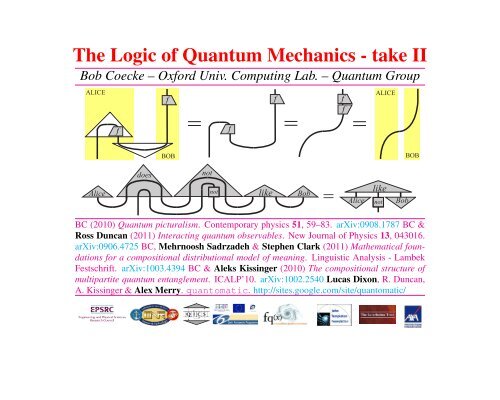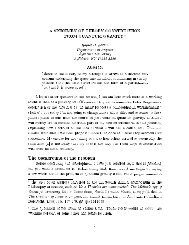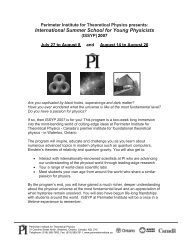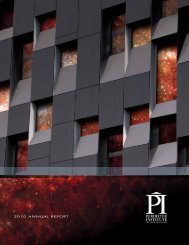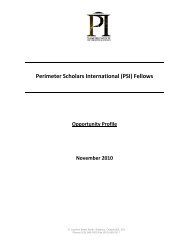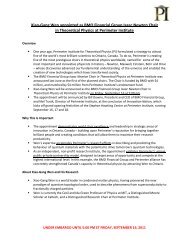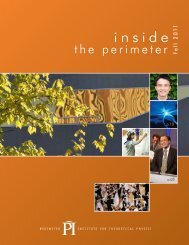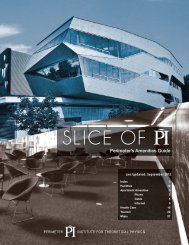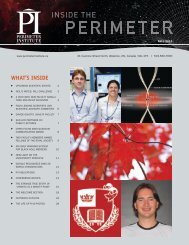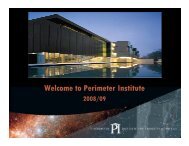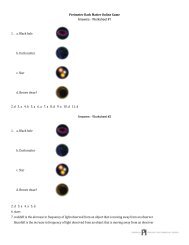The Logic of Quantum Mechanics - take II - Perimeter Institute
The Logic of Quantum Mechanics - take II - Perimeter Institute
The Logic of Quantum Mechanics - take II - Perimeter Institute
You also want an ePaper? Increase the reach of your titles
YUMPU automatically turns print PDFs into web optimized ePapers that Google loves.
<strong>The</strong> <strong>Logic</strong> <strong>of</strong> <strong>Quantum</strong> <strong>Mechanics</strong> - <strong>take</strong> <strong>II</strong><br />
Bob Coecke – Oxford Univ. Computing Lab. – <strong>Quantum</strong> Group<br />
ALICE<br />
f<br />
f<br />
BOB<br />
=<br />
f<br />
f<br />
=<br />
f<br />
f<br />
=<br />
ALICE<br />
BOB<br />
does<br />
not<br />
Alice not like<br />
BC (2010) <strong>Quantum</strong> picturalism. Contemporary physics 51, 59–83. arXiv:0908.1787 BC &<br />
Ross Duncan (2011) Interacting quantum observables. New Journal <strong>of</strong> Physics 13, 043016.<br />
arXiv:0906.4725 BC, Mehrnoosh Sadrzadeh & Stephen Clark (2011) Mathematical foundations<br />
for a compositional distributional model <strong>of</strong> meaning. Linguistic Analysis - Lambek<br />
Festschrift. arXiv:1003.4394 BC & Aleks Kissinger (2010) <strong>The</strong> compositional structure <strong>of</strong><br />
multipartite quantum entanglement. ICALP’10. arXiv:1002.2540 Lucas Dixon, R. Duncan,<br />
A. Kissinger & Alex Merry. quantomatic. http://sites.google.com/site/quantomatic/<br />
Bob<br />
=<br />
Alice<br />
like<br />
not<br />
Bob
INTRODUCTION
— genesis —<br />
[von Neumann 1932] Formalized quantum mechanics<br />
in “Mathematische Grundlagen der Quantenmechanik”
— genesis —<br />
[von Neumann 1932] Formalized quantum mechanics<br />
in “Mathematische Grundlagen der Quantenmechanik”<br />
[von Neumann to Birkh<strong>of</strong>f 1935] “I would like to<br />
make a confession which may seem immoral: I do not<br />
believe absolutely in Hilbert space no more.” (sic)
— genesis —<br />
[von Neumann 1932] Formalized quantum mechanics<br />
in “Mathematische Grundlagen der Quantenmechanik”<br />
[von Neumann to Birkh<strong>of</strong>f 1935] “I would like to<br />
make a confession which may seem immoral: I do not<br />
believe absolutely in Hilbert space no more.” (sic)<br />
[Birkh<strong>of</strong>f and von Neumann 1936] <strong>The</strong> <strong>Logic</strong> <strong>of</strong><br />
<strong>Quantum</strong> <strong>Mechanics</strong> in Annals <strong>of</strong> Mathematics.
— genesis —<br />
[von Neumann 1932] Formalized quantum mechanics<br />
in “Mathematische Grundlagen der Quantenmechanik”<br />
[von Neumann to Birkh<strong>of</strong>f 1935] “I would like to<br />
make a confession which may seem immoral: I do not<br />
believe absolutely in Hilbert space no more.” (sic)<br />
[Birkh<strong>of</strong>f and von Neumann 1936] <strong>The</strong> <strong>Logic</strong> <strong>of</strong><br />
<strong>Quantum</strong> <strong>Mechanics</strong> in Annals <strong>of</strong> Mathematics.<br />
[1936 – 2000] many followed them, ... and FAILED.
— genesis —<br />
[von Neumann 1932] Formalized quantum mechanics<br />
in “Mathematische Grundlagen der Quantenmechanik”<br />
[von Neumann to Birkh<strong>of</strong>f 1935] “I would like to<br />
make a confession which may seem immoral: I do not<br />
believe absolutely in Hilbert space no more.” (sic)<br />
[Birkh<strong>of</strong>f and von Neumann 1936] <strong>The</strong> <strong>Logic</strong> <strong>of</strong><br />
<strong>Quantum</strong> <strong>Mechanics</strong> in Annals <strong>of</strong> Mathematics.<br />
[1936 – 2000] many followed them, ... and FAILED.
— the mathematics <strong>of</strong> it —
— the mathematics <strong>of</strong> it —<br />
Hilber space stuff: continuum, field structure <strong>of</strong> complex<br />
numbers, vector space over it, inner-product, etc.
— the mathematics <strong>of</strong> it —<br />
Hilber space stuff: continuum, field structure <strong>of</strong> complex<br />
numbers, vector space over it, inner-product, etc.<br />
WHY?
— the mathematics <strong>of</strong> it —<br />
Hilber space stuff: continuum, field structure <strong>of</strong> complex<br />
numbers, vector space over it, inner-product, etc.<br />
WHY?<br />
von Neumann: only used it since it was ‘available’.
— the mathematics <strong>of</strong> it —<br />
Hilber space stuff: continuum, field structure <strong>of</strong> complex<br />
numbers, vector space over it, inner-product, etc.<br />
WHY?<br />
von Neumann: only used it since it was ‘available’.<br />
Model theory: one can do almost anything with it.
— the mathematics <strong>of</strong> it —<br />
Hilber space stuff: continuum, field structure <strong>of</strong> complex<br />
numbers, vector space over it, inner-product, etc.<br />
WHY?<br />
von Neumann: only used it since it was ‘available’.<br />
Model theory: one can do almost anything with it.<br />
⇒ it comes with little conceptual content ⇐
— the mathematics <strong>of</strong> it —<br />
Hilber space stuff: continuum, field structure <strong>of</strong> complex<br />
numbers, vector space over it, inner-product, etc.<br />
WHY?<br />
von Neumann: only used it since it was ‘available’.<br />
Model theory: one can do almost anything with it.<br />
⇒ it comes with little conceptual content ⇐<br />
SO WHAT ELSE SHOULD ONE USE THEN?
— the physics <strong>of</strong> it —
— the physics <strong>of</strong> it —<br />
von Neumann crafted Birkh<strong>of</strong>f-von Neumann <strong>Quantum</strong><br />
‘<strong>Logic</strong>’ to capture the concept <strong>of</strong> superposition.
— the physics <strong>of</strong> it —<br />
von Neumann crafted Birkh<strong>of</strong>f-von Neumann <strong>Quantum</strong><br />
‘<strong>Logic</strong>’ to capture the concept <strong>of</strong> superposition.<br />
Schrödinger (1935): the stuff which is the true soul <strong>of</strong><br />
quantum theory is how quantum systems compose.
— the physics <strong>of</strong> it —<br />
von Neumann crafted Birkh<strong>of</strong>f-von Neumann <strong>Quantum</strong><br />
‘<strong>Logic</strong>’ to capture the concept <strong>of</strong> superposition.<br />
Schrödinger (1935): the stuff which is the true soul <strong>of</strong><br />
quantum theory is how quantum systems compose.<br />
<strong>Quantum</strong> Computer Scientists: Schrödinger is right!
— the physics <strong>of</strong> it —<br />
von Neumann crafted Birkh<strong>of</strong>f-von Neumann <strong>Quantum</strong><br />
‘<strong>Logic</strong>’ to capture the concept <strong>of</strong> superposition.<br />
Schrödinger (1935): the stuff which is the true soul <strong>of</strong><br />
quantum theory is how quantum systems compose.<br />
<strong>Quantum</strong> Computer Scientists: Schrödinger is right!<br />
75 years later Birkh<strong>of</strong>f-von Neumann quantum ‘logicians’<br />
still fail to elegantly capture composition <strong>of</strong> quantum<br />
systems, ... nor much else neiter, ...
— the game plan —
— the game plan —<br />
Task 0. Solve:<br />
tensor product structure<br />
the other stuff<br />
= ???
— the game plan —<br />
Task 0. Solve:<br />
tensor product structure<br />
the other stuff<br />
= ???<br />
i.e. axiomatize “⊗” without reference to spaces.
— the game plan —<br />
Task 0. Solve:<br />
tensor product structure<br />
the other stuff<br />
= ???<br />
i.e. axiomatize “⊗” without reference to spaces.<br />
Task 1. Investigate which assumptions (i.e. which structure)<br />
on ⊗ is needed to deduce physical phenomena?
— the game plan —<br />
Task 0. Solve:<br />
tensor product structure<br />
the other stuff<br />
= ???<br />
i.e. axiomatize “⊗” without reference to spaces.<br />
Task 1. Investigate which assumptions (i.e. which structure)<br />
on ⊗ is needed to deduce physical phenomena?<br />
Task 2. Investigate wether such an “interaction structure”<br />
appear elsewhere in “our classical reality”
Outcome 1a: “Sheer ratio <strong>of</strong> results to assumptions”
Outcome 1a: “Sheer ratio <strong>of</strong> results to assumptions”<br />
confirms that we are probing something very essential.<br />
Hans Halvorson (2010) Editorial to: Deep Beauty: Understanding the <strong>Quantum</strong><br />
World through Mathematical Innovation, Cambridge University Press.
Outcome 1a: “Sheer ratio <strong>of</strong> results to assumptions”<br />
confirms that we are probing something very essential.<br />
Hans Halvorson (2010) Editorial to: Deep Beauty: Understanding the <strong>Quantum</strong><br />
World through Mathematical Innovation, Cambridge University Press.
Outcome 1a: “Sheer ratio <strong>of</strong> results to assumptions”<br />
confirms that we are probing something very essential.<br />
Outcome 1b: Exposing this structure has already helped<br />
to solve open problems elsewhere. (e.g. 2× ICALP’10)<br />
E.g.: Ross Duncan & Simon Perdrix (2010) Rewriting measurement-based<br />
quantum computations with generalised flow. ICALP’10.
Outcome 1a: “Sheer ratio <strong>of</strong> results to assumptions”<br />
confirms that we are probing something very essential.<br />
Outcome 1b: Exposing this structure has already helped<br />
to solve open problems elsewhere. (e.g. 2× ICALP’10)<br />
Outcome 1c: Framework is a simple intuitive (but<br />
rigorous) diagrammatic language, meanwhile adopted<br />
by others e.g. Lucien Hardy in arXiv:1005.5164:<br />
“... we join the quantum picturalism revolution [1]”<br />
[1] BC (2010) <strong>Quantum</strong> picturalism. Contemporary Physics 51, 59–83.
Outcome 1a: “Sheer ratio <strong>of</strong> results to assumptions”<br />
confirms that we are probing something very essential.<br />
Outcome 1b: Exposing this structure has already helped<br />
to solve open problems elsewhere. (e.g. 2× ICALP’10)<br />
Outcome 1c: Framework is a simple intuitive (but<br />
rigorous) diagrammatic language, meanwhile adopted<br />
by others e.g. Lucien Hardy in arXiv:1005.5164:<br />
“... we join the quantum picturalism revolution [1]”<br />
[1] BC (2010) <strong>Quantum</strong> picturalism. Contemporary Physics 51, 59–83.
Outcome 2a:
Outcome 2a:<br />
Behaviors <strong>of</strong> matter (Abramsky-C; LiCS’04, quant-ph/0402130) :<br />
ALICE<br />
f<br />
f<br />
BOB<br />
=<br />
f<br />
f<br />
=<br />
f<br />
f<br />
=<br />
ALICE<br />
BOB<br />
Meaning in language (Clark-C-Sadrzadeh; Linguistic Analysis, arXiv:1003.4394) :<br />
meaning vectors <strong>of</strong> words<br />
does<br />
not<br />
Alice not like Bob<br />
pregroup grammar<br />
=<br />
like<br />
Alice not Bob<br />
Knowledge updating (C-Spekkens; Synthese, arXiv:1102.2368) :<br />
P(C|AB)<br />
=<br />
P(AB|C) P(A|C) P(B|C) P(C|A) P(C|B)<br />
A<br />
=<br />
conditional<br />
independence<br />
A<br />
=<br />
B<br />
A<br />
A<br />
B<br />
A<br />
=<br />
C<br />
C -1<br />
C -1<br />
P(C|B) P(C|A)<br />
B A<br />
(BA) -1
— the logic <strong>of</strong> it —
— the logic <strong>of</strong> it —<br />
WHAT IS “LOGIC”?
— the logic <strong>of</strong> it —<br />
WHAT IS “LOGIC”?<br />
Definitely not Birkh<strong>of</strong>f-von Neumann quantum logic,<br />
which, by definition, is ‘logic without deduction’, nor<br />
is it
— the logic <strong>of</strong> it —<br />
WHAT IS “LOGIC”?<br />
Definitely not Birkh<strong>of</strong>f-von Neumann quantum logic,<br />
which, by definition, is ‘logic without deduction’, nor<br />
is it some metaphysical jargon (cf. Putnam, Omnés, ...)<br />
aiming to solve the measurement problem.
— the logic <strong>of</strong> it —<br />
WHAT IS “LOGIC”?<br />
Pragmatic option 1: <strong>Logic</strong> is structure in language.
— the logic <strong>of</strong> it —<br />
WHAT IS “LOGIC”?<br />
Pragmatic option 1: <strong>Logic</strong> is structure in language.<br />
“Alice and Bob ate everything or nothing, then got sick.”<br />
connectives (∧, ∨) : and, or<br />
negation (¬) : not (cf. nothing = not something)<br />
entailment (⇒) : then<br />
quantifiers (∀, ∃) : every(thing), some(thing)<br />
constants (a, b) : thing<br />
variable (x) : Alice, Bob<br />
predicates (P (x), R(x, y)) : eating, getting sick<br />
truth valuation (0, 1) : true, false<br />
(∀z : Eat(a, z) ∧ Eat(b, z)) ∧ ¬(∃z : Eat(a, z) ∧ Eat(b, z)) ⇒ Sick(a), Sick(b)
— the logic <strong>of</strong> it —<br />
WHAT IS “LOGIC”?<br />
Pragmatic option 1: <strong>Logic</strong> is structure in language.<br />
Pragmatic option 2: <strong>Logic</strong> lets machines reason.
— the logic <strong>of</strong> it —<br />
WHAT IS “LOGIC”?<br />
Pragmatic option 1: <strong>Logic</strong> is structure in language.<br />
Pragmatic option 2: <strong>Logic</strong> lets machines reason.<br />
Cf. the s<strong>of</strong>t incarnation <strong>of</strong> AI in robotics, automated<br />
theorem proving, automated theory exploration, ...
— the logic <strong>of</strong> it —<br />
WHAT IS “LOGIC”?<br />
Pragmatic option 1: <strong>Logic</strong> is structure in language.<br />
Pragmatic option 2: <strong>Logic</strong> lets machines reason.<br />
Our framework appeals to both senses <strong>of</strong> logic, and<br />
moreover induces important new applications:
— the logic <strong>of</strong> it —<br />
WHAT IS “LOGIC”?<br />
Pragmatic option 1: <strong>Logic</strong> is structure in language.<br />
Pragmatic option 2: <strong>Logic</strong> lets machines reason.<br />
Our framework appeals to both senses <strong>of</strong> logic, and<br />
moreover induces important new applications:<br />
From truth to meaning in natural language processing:<br />
— (December 2010)
— the logic <strong>of</strong> it —<br />
WHAT IS “LOGIC”?<br />
Pragmatic option 1: <strong>Logic</strong> is structure in language.<br />
Pragmatic option 2: <strong>Logic</strong> lets machines reason.<br />
Our framework appeals to both senses <strong>of</strong> logic, and<br />
moreover induces important new applications:<br />
From truth to meaning in natural language processing:<br />
— (December 2010)<br />
Automated theorem generation for graphical theories:<br />
— http://sites.google.com/site/quantomatic/
BASIC TENSOR LOGIC<br />
Roger Penrose (1971) Applications <strong>of</strong> negative dimensional tensors. In: Combinatorial<br />
Mathematics and its Applications, 221–244. Academic Press.<br />
André Joyal and Ross Street (1991) <strong>The</strong> Geometry <strong>of</strong> tensor calculus I. Advances<br />
in Mathematics 88, 55–112.
— the data <strong>of</strong> tensor logic —<br />
Box : =<br />
f<br />
output wire(s)<br />
input wire(s)
— the data <strong>of</strong> tensor logic —<br />
Box : =<br />
f<br />
output wire(s)<br />
input wire(s)<br />
Interpretation: wire := system ; box := process
— the data <strong>of</strong> tensor logic —<br />
Box : =<br />
f<br />
output wire(s)<br />
input wire(s)<br />
Interpretation: wire := system ; box := process<br />
one system: n subsystems: no system:<br />
. . .<br />
}{{}<br />
1<br />
} {{ }<br />
n<br />
}{{}<br />
0
— the connectives <strong>of</strong> tensor logic —
— the connectives <strong>of</strong> tensor logic —<br />
sequential or causal or connected composition:<br />
g ◦ f ≡<br />
g<br />
f
— the connectives <strong>of</strong> tensor logic —<br />
sequential or causal or connected composition:<br />
g ◦ f ≡<br />
g<br />
f<br />
parallel or acausal or disconnected composition:<br />
f ⊗ g ≡ f fg
— merely a new notation? —
— merely a new notation? —<br />
(g ◦ f) ⊗ (k ◦ h) = (g ⊗ k) ◦ (f ⊗ h)
— merely a new notation? —<br />
(g ◦ f) ⊗ (k ◦ h) = (f ◦ h) ⊗ (g ◦ k)<br />
g<br />
f<br />
k<br />
h
— merely a new notation? —<br />
(f ⊗ g) ◦ (h ⊗ k) = (g ⊗ k) ◦ (f ⊗ h)<br />
g<br />
f<br />
k<br />
h
— merely a new notation? —<br />
(g ◦ f) ⊗ (k ◦ h) = (g ⊗ k) ◦ (f ⊗ h)<br />
g<br />
k<br />
g<br />
k<br />
f<br />
h<br />
=<br />
f<br />
h
— merely a new notation? —<br />
(g ◦ f) ⊗ (k ◦ h) = (g ⊗ k) ◦ (f ⊗ h)<br />
g<br />
k<br />
g<br />
k<br />
f<br />
h<br />
=<br />
f<br />
h<br />
peel potato and then fry it,<br />
while,<br />
clean carrot and then boil it<br />
=<br />
peel potato while clean carrot,<br />
and then,<br />
fry potato while boil carrot
— topological connectedness as a paradigm —<br />
g<br />
f<br />
f<br />
fg<br />
connected<br />
disconnected
— topological connectedness as a paradigm —<br />
g<br />
f<br />
f<br />
fg<br />
connected<br />
This is a digital paradigm:<br />
disconnected
— topological connectedness as a paradigm —<br />
g<br />
f<br />
f<br />
fg<br />
connected<br />
disconnected<br />
This is a digital paradigm:<br />
0 ∼ no information-flow 1 ∼ information-flow
=<br />
= =<br />
— topological connectedness as a paradigm —<br />
dot = ground =<br />
mixedness<br />
decoherence<br />
eigenstate<br />
complementarity<br />
=<br />
GHZ-state vs W-state
A MINIMAL LANGUAGE<br />
FOR QUANTUM REASONING<br />
Samson Abramsky & BC (2004) A categorical semantics for quantum protocols.<br />
In: IEEE-LiCS’04. quant-ph/0402130<br />
BC (2005) Kindergarten quantum mechanics. quant-ph/0510032
— graphical notation for states and effects —<br />
ψ : I → A π : A → I π ◦ ψ : I → I<br />
ψ<br />
π<br />
π<br />
ψ
— graphical notation for states and effects —<br />
ψ : I → A π : A → I π ◦ ψ : I → I<br />
ψ<br />
π<br />
π<br />
ψ
— graphical notation for states and effects —<br />
ψ : I → A π : A → I π ◦ ψ : I → I<br />
ψ<br />
π<br />
π<br />
ψ
— graphical notation for states and effects —<br />
ψ : I → A π : A → I π ◦ ψ : I → I<br />
ψ<br />
π<br />
π<br />
ψ
— graphical notation for states and effects —<br />
ψ : I → A π : A → I π ◦ ψ : I → I<br />
ψ<br />
π<br />
π<br />
ψ
— graphical notation for states and effects —<br />
ψ : I → A π : A → I π ◦ ψ : I → I<br />
ψ<br />
π<br />
π<br />
ψ
— graphical notation for states and effects —<br />
ψ : I → A π : A → I π ◦ ψ : I → I<br />
ψ<br />
π<br />
π<br />
ψ
— graphical notation for states and effects —<br />
ψ : I → A π : A → I π ◦ ψ : I → I<br />
ψ<br />
π<br />
π<br />
ψ
— graphical notation for states and effects —<br />
ψ : I → A π : A → I π ◦ ψ : I → I<br />
ψ<br />
π<br />
π<br />
ψ
— graphical notation for states and effects —<br />
ψ : I → A π : A → I π ◦ ψ : I → I<br />
ψ<br />
π<br />
π<br />
ψ
— adjoint —<br />
f : A → B<br />
B<br />
f<br />
A
— adjoint —<br />
f † : B → A<br />
A<br />
f<br />
B
=<br />
=<br />
— asserting (pure) entanglement —<br />
quantum<br />
classical<br />
=
=<br />
=<br />
— asserting (pure) entanglement —<br />
quantum<br />
classical<br />
=<br />
⇒ introduce ‘parallel connection between systems’:
— quantum-like —<br />
=
— quantum-like —<br />
=
— sliding —<br />
f<br />
f<br />
=<br />
f<br />
=<br />
f
classical data flow?<br />
f<br />
f<br />
f<br />
f<br />
=
classical data flow?<br />
f<br />
f<br />
=
classical data flow?<br />
f<br />
f<br />
=
classical data flow?<br />
ALICE<br />
f<br />
ALICE<br />
f<br />
=<br />
BOB<br />
BOB<br />
⇒ quantum teleportation
— symbolically: dagger compact categories —
— symbolically: dagger compact categories —<br />
Thm. [Kelly-Laplaza ’80; Selinger ’05] An equational<br />
statement between expressions in dagger compact<br />
categorical language holds if and only if it is<br />
derivable in the graphical notation via homotopy.
— symbolically: dagger compact categories —<br />
Thm. [Kelly-Laplaza ’80; Selinger ’05] An equational<br />
statement between expressions in dagger compact<br />
categorical language holds if and only if it is<br />
derivable in the graphical notation via homotopy.<br />
there are many models, i.e. concrete dagger compact<br />
categories, e.g. linear maps, relations, ...
— symbolically: dagger compact categories —<br />
Thm. [Kelly-Laplaza ’80; Selinger ’05] An equational<br />
statement between expressions in dagger compact<br />
categorical language holds if and only if it is<br />
derivable in the graphical notation via homotopy.<br />
Thm. [Selinger ’08] An equational statement between<br />
expressions in dagger compact categorical language<br />
holds if and only if it is derivable in the dagger<br />
compact category <strong>of</strong> finite dimensional Hilbert<br />
spaces, linear maps, tensor product and adjoints.
— symbolically: dagger compact categories —<br />
In words: Any equation involving:<br />
• states, operations, effects<br />
• unitarity, adjoints (e.g. self-adjoint), projections<br />
• Bell-states/effects, transpose, conjugation<br />
• inner-product, trace, Hilbert-Schmidt norm<br />
• positivity, completely positive maps, ...<br />
holds in quantum theory if and only if it can be derived<br />
in the graphical language via homotopy.
MEANING IN NATURAL LANGUAGE<br />
BC, Mehrnoosh Sadrzadeh & Stephen Clark (2010) Mathematical foundations<br />
for a compositional distributional model <strong>of</strong> meaning. arXiv:1003.4394
— the from-words-to-a-sentence process —<br />
Consider meanings <strong>of</strong> words (for Google these are vectors):<br />
word 1 word 2 word n<br />
...
— the from-words-to-a-sentence process —<br />
How do we/machines compute meaning <strong>of</strong> sentences?<br />
?<br />
word 1 word 2 word n<br />
...
— the from-words-to-a-sentence process —<br />
How do we/machines compute meaning <strong>of</strong> sentences?<br />
grammar<br />
word 1 word 2 word n<br />
...
— the from-words-to-a-sentence process —<br />
Information flow within a verb:<br />
object<br />
subject<br />
verb
=<br />
— the from-words-to-a-sentence process —<br />
Information flow within a verb:<br />
object<br />
subject<br />
verb<br />
Again we have:
— grammar as pregroups – Lambek ’99 —<br />
I ηl<br />
→ A ⊗ A l<br />
A l ⊗ A ɛl<br />
→ I<br />
Al<br />
A<br />
A A l Ar<br />
A<br />
A A A<br />
I ηr<br />
→ A r ⊗ A A ⊗ A r ɛ r<br />
→ I<br />
A<br />
A<br />
A r<br />
A<br />
A<br />
=<br />
=<br />
=<br />
A<br />
A<br />
l<br />
A<br />
l<br />
A<br />
A<br />
r<br />
A<br />
r<br />
=<br />
A<br />
l<br />
A<br />
l<br />
A<br />
r<br />
A<br />
r
— grammar as pregroups – Lambek ’99 —<br />
For noun type “n”, verb type is “ −1 n · s · n −1 ”, so:<br />
n · −1 n · s · n −1 · n = s
— grammar as pregroups – Lambek ’99 —<br />
For noun type “n”, verb type is “ −1 n · s · n −1 ”, so:<br />
n · −1 n · s · n −1 · n = s<br />
Diagrammatic typing:<br />
n<br />
n<br />
s<br />
-1<br />
n-1<br />
n
— from gammer to meaning —<br />
For noun type “n” and verb type “ −1 n · s · n −1 ”:<br />
n · −1 n · s · n −1 · n = s<br />
Diagrammatic meaning:<br />
flow<br />
flow<br />
n<br />
verb<br />
n
— −−−→ Alice ⊗ −−→ does ⊗ −→ not ⊗ −−→ like ⊗ −−→ Bob —
— −−−→ Alice ⊗ −−→ does ⊗ −→ not ⊗ −−→ like ⊗ −−→ Bob —<br />
grammar<br />
Alice<br />
does<br />
not<br />
not<br />
like<br />
Bob<br />
meaning vectors <strong>of</strong> words
— −−−→ Alice ⊗ −−→ does ⊗ −→ not ⊗ −−→ like ⊗ −−→ Bob —<br />
grammar<br />
Alice like Bob<br />
not<br />
meaning vectors <strong>of</strong> words
— −−−→ Alice ⊗ −−→ does ⊗ −→ not ⊗ −−→ like ⊗ −−→ Bob —<br />
grammar<br />
Alice like Bob<br />
not<br />
meaning vectors <strong>of</strong> words
— −−−→ Alice ⊗ −−→ does ⊗ −→ not ⊗ −−→ like ⊗ −−→ Bob —<br />
grammar<br />
Alice like Bob<br />
not<br />
meaning vectors <strong>of</strong> words<br />
=<br />
Alice<br />
not<br />
like<br />
Bob
— experiment: word disambiguation —<br />
E.g. what is “saw”’ in: “Alice saw Bob with a saw”.<br />
Edward Grefenstette & Mehrnoosh Sadrzadeh (2011) Experimental support<br />
for a categorical compositional distributional model <strong>of</strong> meaning. Accepted<br />
for: Empirical Methods in Natural Language Processing (EMNLP’11).
grammar<br />
Alice hates Bob<br />
meaning vectors <strong>of</strong> words<br />
f<br />
measurements<br />
f<br />
states
— analogy: “non-local” info-flows —<br />
English (& French):<br />
Hindi:<br />
Persian:<br />
Arabic (and Hebrew):<br />
Mehrnoosh Sadrzadeh (2008) Pregroup analysis <strong>of</strong> Persian sentences.
— analogy: quantizing grammar! —<br />
Topological quantum field theory:<br />
F : nCob → FVect C ::<br />
↦→ V<br />
Grammatical quantum field theory:<br />
F : P regroup → FVect R+ ::<br />
↦→ V<br />
Louis Crane was the first one to notice this analogy.
THE EXTENDED LANGUAGE:<br />
BASES AND COMPLEMENTARITY<br />
Coecke, Pavlovic & Vicary (2008) A new description <strong>of</strong> orthogonal bases.<br />
Mathematical Structures in Computer Science, TA. arXiv:0810.0812<br />
BC & Ross Duncan (IS HERE) (2008) Interacting quantum observables. ICALP’08<br />
& New Journal <strong>of</strong> Physics 13, 043016. arXiv:0906.4725
— commutative Frobenius algebras —
— commutative Frobenius algebras —<br />
A commutative monoid is a set X with a binary map<br />
− • − : X × X → X<br />
which is commutative, associative and unital i.e<br />
(a • b) • c = a • (b • c) a • b = b • a a • 1 = a
— commutative Frobenius algebras —<br />
A commutative monoid is a set X with a binary map<br />
µ(−, −) : X × X → X<br />
which is commutative, associative and unital i.e<br />
µ(µ(a, b), c) = µ(a, µ(b, c)) µ(a, b) = µ(b, a) µ(a, 1) = a
— commutative Frobenius algebras —<br />
A commutative monoid is a set X with a binary map<br />
µ : X × X → X<br />
which is commutative, associative and unital i.e<br />
µ◦(µ×1 X ) = µ◦(1 X ×µ) µ = µ◦σ µ◦(1 X ×e) = 1 X<br />
with:<br />
σ : X × X → X × X :: (a, b) ↦→ (b, a)<br />
e : {∗} → X :: ∗ ↦→ 1
— commutative Frobenius algebras —<br />
A commutative monoid is a set X with a binary map<br />
µ : X × X → X<br />
which is commutative, associative and unital i.e<br />
µ◦(µ×1 X ) = µ◦(1 X ×µ) µ = µ◦σ µ◦(1 X ×e) = 1 X<br />
A cocomutative comonoid is a set X with a binary map<br />
δ : X → X × X<br />
which is cocommutative, coassociative and counital i.e<br />
(δ×1 X )◦δ = (1 X ×δ)◦δ δ = σ◦δ (1 X ×e ′ )◦δ = 1 X
commutative monoid<br />
cocommutative comonoid<br />
+ Z2 ::<br />
× B ::<br />
{ (0, 0), (1, 1) ↦→ 0<br />
(0, 1), (1, 0) ↦→ 1<br />
{ (0, 0), (0, 1), (1, 0) ↦→ 0<br />
(1, 1) ↦→ 1<br />
.<br />
.<br />
.<br />
∆ ::<br />
{ 0 ↦→ (0, 0)<br />
1 ↦→ (1, 1)
— commutative Frobenius algebras —<br />
A commutative monoid is vect. space V & lin. map<br />
µ : V ⊗ V → V<br />
which is commutative, associative and unital i.e<br />
µ◦(µ⊗1 V ) = µ◦(1 V ⊗µ) µ = µ◦σ µ◦(1 V ⊗e) = 1 V<br />
A cocomutative comonoid is vect. space V & lin. map<br />
δ : V → V ⊗ V<br />
which is cocommutative, coassociative and counital i.e<br />
(δ⊗1 V )◦δ = (1 V ⊗δ)◦δ δ = σ◦δ (1 V ⊗e ′ )◦δ = 1 V
commutative monoid<br />
cocommutative comonoid<br />
ˆ+ Z2 ::<br />
{ |00〉, |11〉 ↦→ |0〉<br />
|01〉, |10〉 ↦→ |1〉<br />
ˆ+ † Z 2<br />
::<br />
{ |0〉 ↦→ |00〉, |11〉<br />
|1〉 ↦→ |01〉, |10〉<br />
ˆ× B :: · · · ˆ× † B :: · · ·<br />
δ † Z :: { |00〉 ↦→ |0〉<br />
|11〉 ↦→ |1〉<br />
δ † X :: { | + +〉 ↦→ |+〉<br />
| − −〉 ↦→ |−〉<br />
δ Z ::<br />
δ X ::<br />
{ |0〉 ↦→ |00〉<br />
|1〉 ↦→ |11〉<br />
{ |+〉 ↦→ | + +〉<br />
|−〉 ↦→ | − −〉<br />
δ † Y :: · · · δ Y :: · · ·
— commutative Frobenius algebras —<br />
A commutative monoid is:<br />
such that<br />
= = =<br />
A cocomutative comonoid is:<br />
such that<br />
= = =
— commutative Frobenius algebras —<br />
A commutative Frobenius algebra is a commutative<br />
monoid and a commutative comonoid:<br />
which moreover satisfy:<br />
=
commutative monoid<br />
cocommutative comonoid<br />
ˆ+ Z2 ::<br />
{ |00〉, |11〉 ↦→ |0〉<br />
|01〉, |10〉 ↦→ |1〉<br />
ˆ+ † Z 2<br />
::<br />
{ |0〉 ↦→ |00〉, |11〉<br />
|1〉 ↦→ |01〉, |10〉<br />
δ † Z :: { |00〉 ↦→ |0〉<br />
|11〉 ↦→ |1〉<br />
δ † X :: { | + +〉 ↦→ |+〉<br />
| − −〉 ↦→ |−〉<br />
δ Z ::<br />
δ X ::<br />
{ |0〉 ↦→ |00〉<br />
|1〉 ↦→ |11〉<br />
{ |+〉 ↦→ | + +〉<br />
|−〉 ↦→ | − −〉<br />
δ † Y :: · · · δ Y :: · · ·
— bases in tensor logic —<br />
<strong>The</strong> notion <strong>of</strong> a(n) (orthonormal) basis can be captured<br />
purely in the language <strong>of</strong> tensor logic:<br />
Thm. Dagger special commutative Frobenius algebras:<br />
( ) †<br />
=<br />
=<br />
( ) †<br />
=<br />
are the same thing as orthonormal bases; the basis vectors<br />
are the vectors copied by the comultiplication.<br />
BC, Dusko Pavlovic & Jamie Vicary (2008) A new description <strong>of</strong> orthogonal<br />
bases. Mathematical Structures in Computer Science. arXiv:0810.0812
....<br />
CFA normal form depends on ♯inputs, ♯outputs, ♯loops:<br />
...<br />
....
such that, for k > 0:<br />
— spiders —<br />
⎧ ⎫<br />
m<br />
{ }} ⎪⎨ .... { ⎪⎬<br />
‘spiders’ =<br />
.... ⎪⎩ } {{ } ⎪⎭<br />
m+m ′ −k<br />
{ }} {<br />
....<br />
....<br />
....<br />
....<br />
....<br />
} {{ }<br />
n+n ′ −k<br />
=<br />
n<br />
....<br />
....<br />
Coecke, Pavlovic & Vicary (2006, 2008) quant-ph/0608035, 0810.0812
such that, for k > 0:<br />
— spiders —<br />
⎧ ⎫<br />
m<br />
{ }} ⎪⎨ .... { ⎪⎬<br />
‘(co-)mult.’ =<br />
.... ⎪⎩ } {{ } ⎪⎭<br />
m+m ′ −k<br />
{ }} {<br />
....<br />
....<br />
....<br />
....<br />
....<br />
} {{ }<br />
n+n ′ −k<br />
=<br />
n<br />
....<br />
....
such that, for k > 0:<br />
— spiders —<br />
⎧ ⎫<br />
m<br />
{ }} ⎪⎨ .... { ⎪⎬<br />
‘(co-)mult.’ =<br />
.... ⎪⎩ } {{ } ⎪⎭<br />
m+m ′ −k<br />
{ }} {<br />
....<br />
....<br />
....<br />
....<br />
....<br />
} {{ }<br />
n+n ′ −k<br />
=<br />
n<br />
....<br />
....
such that, for k > 0:<br />
— spiders —<br />
⎧ ⎫<br />
m<br />
{ }} ⎪⎨ .... { ⎪⎬<br />
‘cups/caps’ =<br />
.... ⎪⎩ } {{ } ⎪⎭<br />
m+m ′ −k<br />
{ }} {<br />
....<br />
....<br />
....<br />
....<br />
....<br />
} {{ }<br />
n+n ′ −k<br />
=<br />
n<br />
....<br />
....<br />
Coecke, Pavlovic & Vicary (2006, 2008) quant-ph/0608035, 0810.0812
— complementary bases —
Thm.<br />
— complementary bases —<br />
BC & Ross Duncan (IS HERE) (2008) Interacting quantum observables. ICALP’08<br />
& New Journal <strong>of</strong> Physics 13, 043016. arXiv:0906.4725
— quantum gates —<br />
Z-spin:<br />
δ Z : |i〉 ↦→ |ii〉<br />
X-spin:<br />
δ X : |±〉 ↦→ | ± ±〉
— quantum gates —<br />
i.e.<br />
(δ † Z ⊗ 1) ◦ (1 ⊗ δ X) =<br />
⎛<br />
⎜<br />
⎝<br />
1 0 0 0<br />
0 1 0 0<br />
0 0 0 1<br />
0 0 1 0<br />
⎞<br />
⎟<br />
⎠ = CNOT
— quantum gates —<br />
⎛<br />
⎜<br />
⎝<br />
1 0 0 0<br />
0 1 0 0<br />
0 0 0 1<br />
0 0 1 0<br />
⎞ ⎛<br />
⎟<br />
⎠ ◦ ⎜<br />
⎝<br />
1 0 0 0<br />
0 1 0 0<br />
0 0 0 1<br />
0 0 1 0<br />
⎞<br />
⎟<br />
⎠ = ?
— quantum gates —
— quantum gates —
— quantum gates —
— quantum gates —
— classical communication and control —
— classical communication and control —
— classical communication and control —
— classical communication and control —
— classical communication and control —
— classical communication and control —
— classical communication and control —
qubit 1 the leftmost, and qubit 4 is the rightmost.<br />
By virtue <strong>of</strong> the soundness <strong>of</strong> R and Proposition 10, if D P can be rewritten<br />
to a circuit-like diagram without any conditional operations, then the rewrite<br />
sequence constitutes a pro<strong>of</strong> that the pattern computes the same operation as<br />
— applications to QC models —<br />
the derived circuit.<br />
Example 19. Returning to the CNOT pattern <strong>of</strong> Example 18, there is a rewrite<br />
Translating measurement based quantum computations<br />
sequence, the key steps <strong>of</strong> which are shown below, which reduces the D P to<br />
to thecircuits unconditional without circuit-like additional pattern for CNOT resources: introduced in Example 7. This<br />
proves two things: firstly that P indeed computes the CNOT unitary, and that<br />
the pattern P is deterministic.<br />
H<br />
π, {2}<br />
H<br />
π, {3}<br />
H<br />
π, {2}<br />
π, {3}<br />
π, {2}<br />
∗ ✲<br />
H<br />
H<br />
H<br />
π, {2}<br />
π, {3}<br />
π, {2}<br />
π, {2} π, {3}<br />
∗ ✲<br />
π, {2}<br />
H<br />
H<br />
H<br />
π, {2}<br />
π, {2}<br />
π, {3}<br />
π, {3}<br />
∗ ✲<br />
π, {2}<br />
π, {2}<br />
π, {2}<br />
∗ ✲<br />
π, {2} π, {2}<br />
π, {2}<br />
π, {2}<br />
∗ ✲<br />
One can clearly see in this example how the non-determinism introduced by<br />
measurements is corrected by conditional operations later in the pattern. <strong>The</strong><br />
Ross possibility Duncan <strong>of</strong> performing (IS HERE) such & Simon corrections Perdrix depends (2010) onRewriting the geometry measurementbasetern,<br />
the quantum entanglement computations graph with implicitly generalised definedflow. by the ICALP’10.<br />
<strong>of</strong> the pat-<br />
pattern.<br />
Definition 20. Let P be a pattern; the geometry <strong>of</strong> P is an open graph γ(P) =<br />
(G, I, O) whose vertices are the qubits <strong>of</strong> P and where i ∼ j iff E ij occurs in the<br />
command sequence <strong>of</strong> P.<br />
Definition 21. Given a geometry Γ = ((V, E), I, O) we can define a diagram
— applications to quantum foundations —<br />
Spekkens’ toy qubit qubit theory and stabilizer quantum<br />
theory within one framework.<br />
(Non-)locality can be reduced to the ‘phase group’:<br />
Spekkens’ qubit QM<br />
stabilizer qubit QM = Z 2 × Z 2<br />
Z 4<br />
=<br />
local<br />
non-local<br />
Z 4 Z 2 × Z 2<br />
BC, Bill Edwards (COMES HERE) & Robert W. Spekkens (2010) Phase<br />
groups and the origin <strong>of</strong> non-locality for qubits. arXiv:1003.5005
— automated theory exploration —<br />
Lucas Dixon (Google), Ross Duncan (Brussels, IS HERE), Aleks Kissinger<br />
(Oxford, IS HERE AND HAS A POSTER ON THIS) & Alex Merry (Oxford);<br />
website: http://sites.google.com/site/quantomatic/
THE EXTENDED LANGUAGE <strong>II</strong>:<br />
GHZ vs W ENTANGLEMENT<br />
BC & Aleks Kissinger (IS HERE) (2010) <strong>The</strong> compositional structure <strong>of</strong> multipartite<br />
quantum entanglement. ICALP’10. arXiv:1002.2540<br />
BC, A. Kissinger, Alex Merry & Shibdas Roy (2011) <strong>The</strong> GHZ/W-calculus<br />
contains rational arithmetic. arXiv:1103.2812
Defn. Special CFA (SCFA):<br />
=
=<br />
Defn. Special CFA (SCFA):<br />
Lem. Loop invertible ⇒ special up to phase.
=<br />
=<br />
Defn. Special CFA (SCFA):<br />
Lem. Loop invertible ⇒ special up to phase.<br />
Defn. Anti-special CFA (ACFA):
=<br />
=<br />
Defn. Special CFA (SCFA):<br />
Lem. Loop invertible ⇒ special up to phase.<br />
Defn. Anti-special CFA (ACFA):<br />
Lem. [Herrmann] Loop disconnected ⇒ antispecial.
— C(F)As ←→ tripartite states —<br />
A comultiplication & unit yield a tripartite state:<br />
=
=<br />
<strong>The</strong>orem. If a CFA on C 2 is special, that is,<br />
it induces a GHZ-class Frobenius state, and vice versa.
=<br />
=<br />
<strong>The</strong>orem. If a CFA on C 2 is special, that is,<br />
it induces a GHZ-class Frobenius state, and vice versa.<br />
<strong>The</strong>orem. If a CFA on C 2 is anti-special, that is,<br />
it induces a W-class Frobenius state, and vice versa.
— GHZ algebra —<br />
(<br />
1 0 0 0<br />
)<br />
(<br />
1<br />
1<br />
)<br />
=<br />
0 0 0 1<br />
=<br />
=<br />
⎛<br />
⎜<br />
⎝<br />
1 0<br />
0 0<br />
0 0<br />
0 1<br />
⎞<br />
⎟<br />
⎠<br />
= ( 1 1 )<br />
= ( 1 0 0 1 ) = 〈00| + 〈11|
— W algebra —<br />
(<br />
1 0 0 0<br />
)<br />
(<br />
1<br />
0<br />
)<br />
=<br />
0 1 1 0<br />
=<br />
=<br />
⎛<br />
⎜<br />
⎝<br />
0 0<br />
1 0<br />
1 0<br />
0 1<br />
⎞<br />
⎟<br />
⎠<br />
= ( 0 1 )<br />
= ( 0 1 1 0 ) = 〈01| + 〈10|
— GHZ “spiders” —<br />
Data:<br />
m<br />
⎧⎪ { }} {<br />
⎨<br />
⎪ ⎩<br />
Rules:<br />
....<br />
....<br />
} {{ }<br />
n<br />
m+m ′ −k(≥1)<br />
{ }} {<br />
....<br />
....<br />
....<br />
....<br />
....<br />
} {{ }<br />
n+n ′ −k(≥1)<br />
∣ n, m ∈ N<br />
⎫⎪ ⎬<br />
⎪ ⎭<br />
=<br />
m+m ′ −k(≥1)<br />
{ }} {<br />
....<br />
....<br />
} {{ }<br />
n+n ′ −k(≥1)
— W “exploding spiders” —<br />
Data:<br />
m<br />
⎧⎪ { }} {<br />
⎨<br />
⎪ ⎩<br />
Rules:<br />
....<br />
....<br />
} {{ }<br />
n<br />
m+m ′ −1<br />
, ,<br />
{ }} {<br />
....<br />
.... ....<br />
....<br />
} {{ }<br />
n+n ′ −1<br />
=<br />
∣ n, m ∈ N<br />
⎫⎪ ⎬<br />
⎪ ⎭<br />
m+m ′ −1<br />
{ }} {<br />
....<br />
....<br />
} {{ }<br />
n+n ′ −1
— ACFA “exploding spiders” —<br />
Data:<br />
m<br />
⎧⎪ { }} {<br />
⎨<br />
⎪ ⎩<br />
Rules:<br />
....<br />
....<br />
} {{ }<br />
n<br />
m+m ′ −k(≥2)<br />
, ,<br />
{ }} {<br />
....<br />
.... ....<br />
....<br />
} {{ }<br />
n+n ′ −k(≥2)<br />
=<br />
∣ n, m ∈ N<br />
⎫⎪ ⎬<br />
⎪ ⎭<br />
m+m ′ −k(≥2)<br />
{ }} {<br />
....<br />
....<br />
} {{ }<br />
n+n ′ −k(≥2)
— GHZ-W interaction —
Informatics<br />
information flow<br />
vs<br />
no information flow<br />
— GHZ-W interaction —<br />
Topology<br />
connected<br />
vs<br />
disconnected<br />
Algebra<br />
vs<br />
Entanglement<br />
GHZ vs W<br />
= =<br />
vs
Informatics<br />
information flow<br />
vs<br />
no information flow<br />
— GHZ-W interaction —<br />
Topology<br />
connected<br />
vs<br />
disconnected<br />
Calculus<br />
vs +<br />
Algebra<br />
vs<br />
Entanglement<br />
GHZ vs W<br />
= =<br />
vs
( ) (( )<br />
1 0 0 0 1<br />
z<br />
0 0 0 1<br />
} {{ }<br />
GHZ-mult.<br />
⊗<br />
( 1<br />
z ′ ))<br />
=<br />
( 1<br />
z × z ′ )
( ) (( ) ( ))<br />
1 0 0 0 1 1<br />
⊗<br />
0 0 0 1 z z ′<br />
} {{ }<br />
GHZ-mult.<br />
( ) (( ) ( ))<br />
1 0 0 0 1 1<br />
⊗<br />
0 1 1 0 z z ′<br />
} {{ }<br />
W-mult.<br />
=<br />
=<br />
( 1<br />
z × z ′ )<br />
( 1<br />
z + z ′ )
( ) (( ) ( )) ( )<br />
1 0 0 0 1 1 1<br />
⊗<br />
0 0 0 1 z z ′ =<br />
z × z ′<br />
} {{ }<br />
GHZ-mult.<br />
( ) (( ) ( )) ( )<br />
1 0 0 0 1 1 1<br />
⊗<br />
0 1 1 0 z z ′ =<br />
z + z ′<br />
} {{ }<br />
W-mult.<br />
( ) 1<br />
Encoding states as z ⇒ GHZ = × , W = +<br />
z
( ) (( ) ( )) ( )<br />
1 0 0 0 1 1 1<br />
⊗<br />
0 0 0 1 z z ′ =<br />
z × z ′<br />
} {{ }<br />
GHZ-mult.<br />
( ) (( ) ( )) ( )<br />
1 0 0 0 1 1 1<br />
⊗<br />
0 1 1 0 z z ′ =<br />
z + z ′<br />
} {{ }<br />
W-mult.<br />
( ) 1<br />
Encoding states as z ⇒ GHZ = × , W = +<br />
z<br />
⇒ GHZ and W interact via distributivity ⇐
— challenge —<br />
What can we do with stuff <strong>of</strong> this kind:<br />
Given that:<br />
• GHZ/W-calculus encodes rational arithmetic<br />
• We have automation support
Posters on this line <strong>of</strong> work:<br />
• Aleks Kissinger: Synthesising physical theories.<br />
• Raymond Lal: Causal structure in categorical quantum<br />
mechanics.<br />
• Johan Paulsson: Towards a diagrammatic representation<br />
<strong>of</strong> classical data.<br />
Also from the Oxford gang:<br />
• Shane Mansfield: Hardy’s non-locality paradox and<br />
other possibilistic non-locality conditions.<br />
Want to learn this kind <strong>of</strong> category theory? Try:<br />
• BC & E. O. Paquette (2010) Categories for the practicing<br />
physicist. In: New Structures for Physics.<br />
BC (Ed.), Springer. arXiv:0905.3010


